|
|
|
It's
A Christmas Knockout 1976
Festive Jeux Sans Frontières Special
| |
|
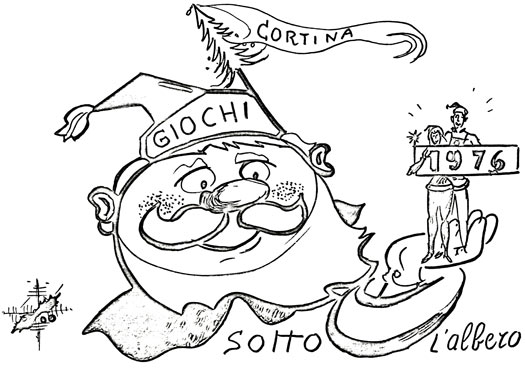 |
|
Image © RAI, 1976 |
| |
Entrants
1976:
Belgium (B) • Great Britain (GB) • Italy (I) • Netherlands (NL)
Presenters / Commentators:
Paule Herreman and Michel Lemaire (B)
Stuart Hall (GB)
Ettore Andenna and Barbara Marchand (I)
Barend Barendse (NL)
International Referees:
Gennaro Olivieri
Guido Pancaldi
National Referees:
Mike Swann (GB)
Production Credits:
National Producers:
Diane Lange and Nicolas Resimont (B), Cecil Korer (GB), Bernard Prins and
Dick van 't Sant (NL); Games Designer: Adolfo Perani;
Production Secretary:
Isabella Mardessich;
Studio Assistant:
Alessandro Basile;
Props Assistant:
Roberto Danelli;
Music Editor:
Gianni d'Ovidio;
Technical Team Leader:
Sergio Triticucci;
Camera Controllers:
Vittorio Abbatelli and Antonio Ciafaloni;
Vision Mixer:
Carlo Muscatello; Camera Operators:
Alberto di Battista, Ignazio Cerrato, Roberto Chioffi, Mario Colafrancesco
and Fabrizio Gentile;
Sound Technicians:
Luigi Bartolini and Vincenzo Sirena;
Microphones:
Amos Pecorini;
Organisation:
Aldo Sommavilla; Co-ordination: Ugo Cameroni;
Producer:
Luciano Vecchi
Produced by RAI (I)
in association with RTB-BRT (B), BBC Manchester (GB), NCRV (NL)
|
Key:
International Christmas Special
● =
Winner of Christmas Special
▲ = Promoted to Position / ▼ =
Demoted to Position |
|
|
I |
It's
A Christmas Knockout 1976 |
Christmas
Special |
|
Event Staged: Tuesday 14th and Wednesday 15th December 1976
Venue:
Stadio Olimpico del Ghiaccio (Olympic Ice Stadium), Cortina d’Ampezzo, Italy
European Transmissions (Local Timings):
BBC1 (GB): Sunday 26th December 1976,
4.35-5.35pm
(Christmas Sunday)
RAI Uno (I): Sunday 26th December 1976,
6.20-8.00pm
(La festa di Santo Stefano)
Nederland 1 (NL): Tuesday 28th December 1976, 8.30-9.35pm |
|
Theme:
Festive Fun |
|
Teams:
Waterloo (B) v. Leeds (GB) v.
Cortina
d’Ampezzo (I) v. Dutch 'All Stars' (NL) |
|
Team Members included:
Dutch 'All Stars' (NL) - Ans Boekema-Schut, Jan Bols, Nico
Chiotakis, Jan Jansen, Harm Kuipers, Atje Keulen-Deelstra, Arie Klein, Eddy
Pieters Graafland, Trijnie Rep, Ans Smulders, Els Veentjer-Spruit, Eddy
Verheyen. |
|
Games:
I Dolci... Dispettosi (The Exploding Christmas Cakes), Salto in Lungo nella
Neve (Curling), L'Albero di Natale e la Palla Gigante (The Christmas Tree and
the Giant Ball), Le Renne e i Regali (The Reindeers and the Gifts), Le Palle
di Neve (Snowballs), L'isola dell'abbondanza (The Island of Plenty),
Inseguimento (The Four-Legged Pursuit) and Finale (Father Christmas' Cloak). |
|
Game Results and Standings |
|
Games |
|
Team /
Colour |
1 |
2 |
3 |
4 |
5 |
6 |
7 |
8 |
|
Points Scored |
|
B |
3 |
4 |
3 |
4 |
4 |
3 |
4 |
4 |
|
GB |
2 |
2 |
2 |
1 |
1 |
1 |
3 |
1 |
|
I |
4 |
3 |
4 |
2 |
3 |
4 |
2 |
3 |
|
NL |
2 |
2 |
2 |
3 |
2 |
2 |
1 |
2 |
Running Totals
(Leading teams shown in red) |
|
B |
3 |
7 |
10 |
14 |
18 |
21 |
25 |
29 |
|
GB |
2 |
4 |
6 |
7 |
8 |
9 |
12 |
13 |
|
I |
4 |
7 |
11 |
13 |
16 |
20 |
22 |
25 |
|
NL |
2 |
4 |
6 |
9 |
11 |
13 |
14 |
16 |
|
|
|
Result |
Team |
Points |
Final Scoreboard |
|
1st
2nd
3rd
4th |
B •
Waterloo ●
I • Cortina d'Ampezzo
NL • Dutch 'All Stars'
GB • Leeds |
29
25
16
13 |
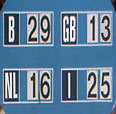 |
|
The Host
Town |
|
Cortina d'Ampezzo, Italy
Cortina d’Ampezzo is a town and winter sport resort with a permanent
population of around 6,200 inhabitants in the Veneto region of northern Italy.
It is located in an alpine valley in the heart of the Dolomites mountain
range, 124km (77 miles) north of Venezia, 257km (159 miles) north-east of
Milano and 120km (75 miles) east of Rateče and the Slovenian border. It is
referred to as the ‘Queen of the Dolomites’ and is known for its ski-ranges,
scenery, accommodation, shops, après-ski scene and its jet-set and European
aristocracy crowd.
Situated at the top of the Valle del Boite, Cortina d’Ampezzo is encircled
360° by the Dolomites. The town centre is located at an elevation of 1,224m
(4,015ft), although the highest point is that of the Tofana di Mezzo which
towers at 3,244m (10,643ft). There is a significant water presence in the
territory in the form of torrents, streams and little lakes, which fill
particularly during the summer snow-melt season. Fauna include marmots, roe
deer chamoises and hares.
During the Middle Ages, Ampezzo fell under the jurisdiction of the Holy Roman
Empire, but in 1420, the village was conquered by the Republic of Venice. In
1508, it was conquered by Austria and by 1511, the people of Ampezzo swore
loyalty to Emperor Maximilian I (1459-1519). Following Italy's victory in
World War I, Ampezzo was finally given to Italy and, although remaining a
Habsburg possession until 1920 and being home to an ethnic German minority,
Ampezzo never became a teutophonic (German-speaking) territory. Instead it
conserved its original language of Ladin, which is similar to the Swiss
Romansch language, but one that is only spoken in the Dolomitic area.
After the War, the town was renamed Cortina d'Ampezzo (Curtain of the Ampezzo
Valley), adopting the name of one of the six villages that made up the
territory of Ampezzo, located in the middle of the Ampezzo valley.
Already an elite destination for the first British tourists from the late 18th
century up to the early twentieth, Cortina d'Ampezzo also became a favourite
resort for upper-class Italians after World War I. On the announcement that
the town had been chosen to host the VIIth Winter Olympic Games of 1956, a new
airport was constructed, which today is no longer in use.
After playing host to the Games, it became a world-renowned resort,
experiencing increased mass tourism and as a result, the town and surroundings
have found themselves being utilised for various world cup events and motion
pictures. Much of 1963 classic The Pink Panther, the progenitor of the
film series starring Peter Sellers (1925-1980), was filmed in Cortina
d’Ampezzo. One of the most memorable James Bond stunt sequences in the 1981
film For Your Eyes Only, where Bond has to escape a crew of assassins
on spike-wheeled motorcycles was filmed there, with his route taking them all
onto the resort’s bobsleigh run. The scene of the first attack on Bond
(portrayed by British actor Roger Moore) and his partner Melina Havelock
(portrayed by French actor Carole Bouquet), in which two motorcyclists
attempt to run them over only for Bond to eliminate them both, was set in the
actual town centre. Since it was not snowing in Cortina d'Ampezzo by the time
of filming, the producers had to pay for trucks to bring snow from nearby
mountains, which was then dumped in the city's streets! Also filmed on its slopes were several scenes in the 1993
film Cliffhanger starring Sylvester Stallone as well as some in the
1983 film Krull starring Ken Marshall and Lysette Anthony.
Following a 70-year hiatus, Cortina d’Ampezzo will again play host to the
Winter Olympics when it shares the honours with Milano in 2026.
|
|
The Venue |
|
Stadio Olimpico del Ghiaccio
(Olympic Ice Stadium)
The
games were played at the Olympic Ice Stadium which was constructed between
1952 and 1954, primarily as an open-air figure skating arena after the town
was awarded the honour of hosting the 1956 Winter Olympic Games.
The
venue was inaugurated on 26th October 1955 and was designed to hold between
7-8,000 spectators, with the possibility of making temporary arrangements to
accommodate 12-15,000 spectators for the period of the Olympics. During the
Games, the arena held the opening and closing ceremonies, the figure skating
events and selected ice hockey games. Although originally open-air, a roof was
added to the structure sometime after 1981.
Akin with the town, the stadium was also utilised in the 1981 film For Your
Eyes Only, where Bond met with the villainous Aris Kristatos (portrayed by
British actor Julian Glover) wherein Kristatos (the real villain) tries to
trick Bond into pursuing and killing his rival Milos Columbo (portrayed by
Israeli actor Chaim Topol).
|
|
The Games
in Detail |
|
Game 1 - I Dolci...
Dispettosi (The Exploding Christmas Cakes)
One
member of each team, wearing a polar bear costume and wielding an ice hockey
stick, must defend their quarter of the central ring of the ice rink. Members
of the opposing teams push firework-propelled Christmas cakes into the ring.
The polar bears must try to push them out of their area before they explode.
The winner is the team with the fewest cakes that explode in their area.
| |
|
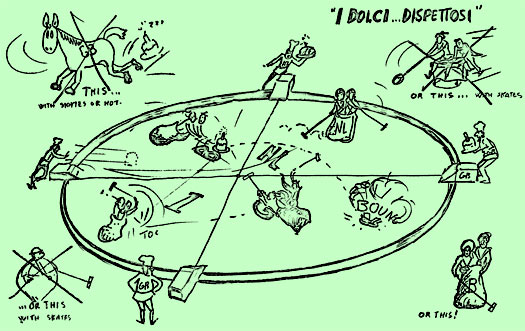 |
|
Image © RAI, 1976 |
| |
|
Running Scores and Positions:
1st Cortina d'Ampezzo (I) (4pts awarded / 4pts total)
2nd Waterloo (B) (3pts / 3pts)
=3rd Leeds (GB) (2pts / 2pts)
=3rd Dutch 'All Stars' (NL) (2pts / 2pts) |
|
Comments:
In the planning stages of this event this game was
originally intended to be played as Game 7. |
Game 2 - Salto in Lungo
nella Neve (Curling)
A
female team member sits on a curling disc and is pushed across the arena by
two of her team mates. When she reaches the ramp (which is well padded) she
reaches out to burst one of a line of balloons, with the nearest being worth
1pt and the furthest 10pts. Each team has four runs and the winner is the team
that achieves the greatest aggregate points score from bursting the balloons.
| |
|
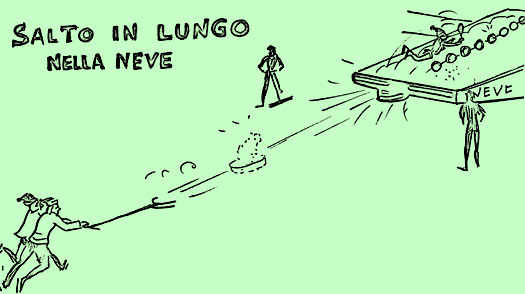 |
|
Image © RAI, 1976 |
| |
|
Running Scores and Positions:
=1st Waterloo (B) (4pts awarded / 7pts total) ▲
=1st Cortina d'Ampezzo (I) (3pts / 7pts)
=3rd Leeds (GB) (2pts / 4pts)
=3rd Dutch 'All Stars' (NL) (2pts / 4pts) |
|
Comments:
In the planning stages of this event this game was
originally intended to be played as Game 6. |
Game 3 - L'Albero di Natale
e la Palla Gigante
(The Christmas Tree and the Giant Ball)
Balloons are blown from the Christmas tree by a hot air fan. The teams must
try to burst the balloons. The winning team will be the one that bursts the
greater number of balloons.
| |
|
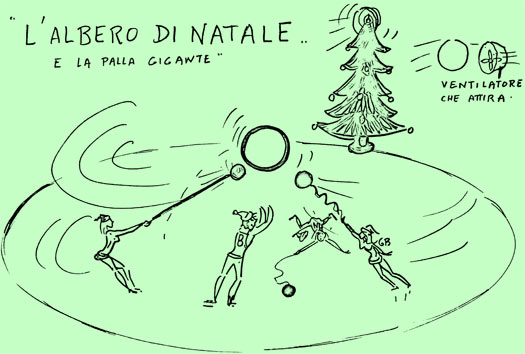 |
|
Image © RAI, 1976 |
| |
|
Running Scores and Positions:
1st Cortina d'Ampezzo (I) (4pts awarded / 11pts total)
2nd Waterloo (B) (3pts / 10pts) ▼
=3rd Leeds (GB) (2pts / 6pts)
=3rd Dutch 'All Stars' (NL) (2pts / 6pts) |
Game 4 - Le Renne e i
Regali (The Reindeers and the Gifts)
The
reindeer transports Christmas presents from a main box, across the ring on its
antlers. An opponent from another team tries to lasso the antlers which break
off. The teams have spare antlers to replace those which are lassoed. The
winner is the team that transports the greater number of presents within the
time limit.
| |
|
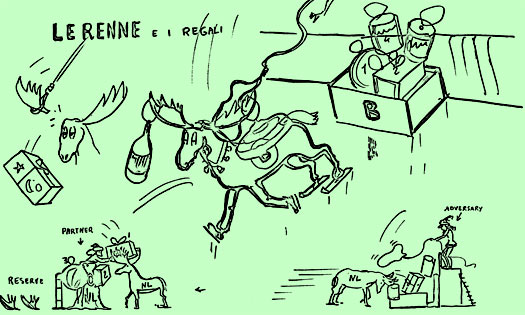 |
|
Image © RAI, 1976 |
| |
|
Running Scores and Positions:
1st Waterloo (B) (4pts awarded / 14pts total) ▲
2nd Cortina d'Ampezzo (I) (2pts / 13pts) ▼
3rd Dutch 'All Stars' (NL) (3pts / 9pts)
4th Leeds (GB) (1pt / 7pts) ▼ |
Game 5 - Le Palle di Neve
(Snowballs)
Two team members sit in a sleigh pulled by two male team mates
in a reindeer costume. The team members in the sleigh throw Velcro snowballs
at a circular target raised on a pole. The teams race to catch the opposing
team ahead of them and burst the hoop at the back of the sleigh to eliminate
their rivals. The winning team will be that which eliminates their opponent
and hits the target with the greater number of snowballs.
| |
|
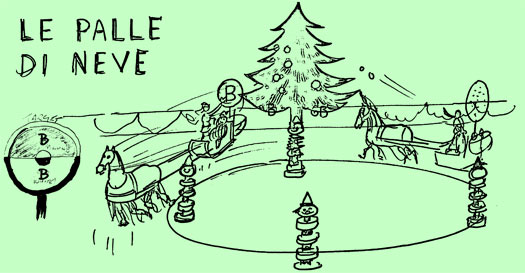 |
|
Image © RAI, 1976 |
| |
|
Running Scores and Positions:
1st Waterloo (B) (4pts awarded / 18pts total)
2nd Cortina d'Ampezzo (I) (3pts / 16pts)
3rd Dutch 'All Stars' (NL) (2pts / 11pts)
4th Leeds (GB) (1pt / 8pts) |
Game 6 - L'isola
dell'abbondanza (The Island of Plenty)
One member of the team, dressed as a polar bear, tries to cross
from one island to the other by means of a bridge which he builds from blocks
on on the island. Two members from an opposing team push a girl on a curling
disc to try to knock away pieces from the bridge. The winning team will be the
first to complete a bridge and cross from one island to the other.
| |
|
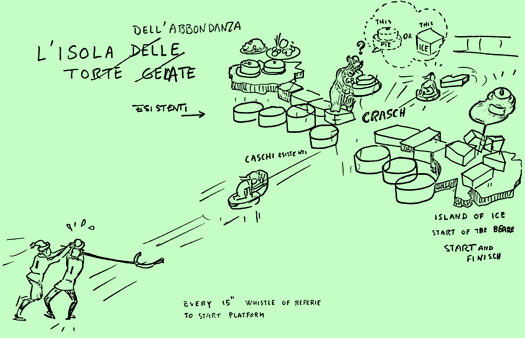 |
|
Image © RAI, 1976 |
| |
|
Running Scores and Positions:
1st Waterloo (B) (3pts awarded / 21pts total)
2nd Cortina d'Ampezzo (I) (4pts / 20pts)
3rd Dutch 'All Stars' (NL) (2pts / 13pts)
4th Leeds (GB) (1pt / 9pts) |
|
Comments:
In the planning stages of this event this game was
originally intended to be played as Game 2. It was initially called
'L'isola della Torte Gelate (The Island of Iced Cakes)'.
The famous clip where British presenter Stuart Hall falls
over on the ice with the giant polar bear (which was re-shown in many
highlights compilations) is taken from this game. |
Game 7 - Inseguimento (The
Four-Legged Pursuit)
An
inflatable dummy on the end of the rope is held between two members of the
team. The dummy is tied to their ankles (as in a three-legged race). The other
end of the rope is held by another member of the team in the centre of the
ring. The teams race to catch the team in front of them. When a team is caught
they are eliminated. The winning team will be the one that no other team
catches..
| |
|
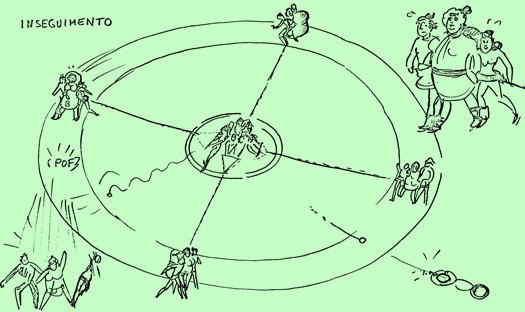 |
|
Image © RAI, 1976 |
| |
|
Running Scores and Positions:
1st Waterloo (B) (4pts awarded / 25pts total)
2nd Cortina d'Ampezzo (I) (2pts / 22pts)
3rd Dutch 'All Stars' (NL) (1pt / 14pts)
4th Leeds (GB) (3pts / 12pts) |
|
Comments:
In the planning stages of this event this game was
originally intended to be played as Game 1. |
Game 8 - Finale
(Father Christmas' Cloak)
One male team member from each team, dressed as Father Christmas, is on a
bicycle. Two other members of the team hold his cloak out behind him.
Different coloured balloons are blown from a central point. The aim is to
catch the balloons of the team's colours in the cloak and transport them to
the champagne glass. The winner is the team with the most balloons of their
colour in the glass at the end of the game.
| |
|
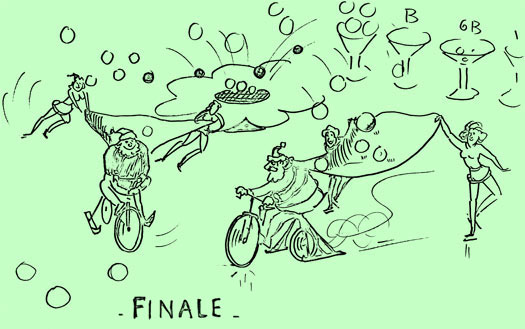 |
|
Image © RAI, 1976 |
| |
|
Final Scores and Positions:
1st Waterloo (B) (4pts awarded / 29pts total)
2nd Cortina d'Ampezzo (I) (3pts / 26pts)
3rd Dutch 'All Stars' (NL) (2pts / 16pts)
4th Leeds (GB) (1pt / 13pts) |
|
|
Made
in Colour • This programme exists in the BBC Archives |
|
|
|
JSFnetGB Series Guide pages researched by
Neil Storer and
Alan Hayes
with Ischa Bijl, Julien Dessy, Sébastien Dias, David Hamilton, Denis Kirsanov, Paul Leaver, Philippe Minet,
Christos Moustakas, David Laich Ruiz, Marko Voštan and JSFnet Websites |
|
|